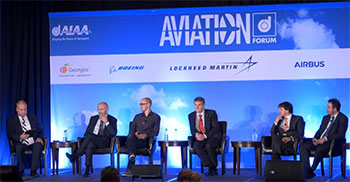Transatlantic Collaboration May Speed Up Safer, Greener, Faster Aviation Written 28 June 2018
Panelists: Moderator David Hills, senior partnership manager, Airbus Americas Inc.; Matej Andrejašič, head of aerodynamics, Pipistrel Vertical Solutions; Pier-Davide Ciampa, team lead, Multidisciplinary Design and Optimization, German Aerospace Center; Sebastiano Fumero, head of unit-aeronautics, Research and Innovation Directorate General, European Commission; Pablo Perez-Illana, program officer, Research and Innovation Directorate General, European Commission; Joeri De Ruytter, Research and Technology Business Development and Partnerships, Honeywell Aerospace Europe
by Michele McDonald, AIAA Communications Manager

Collaborating with the European aerospace community could expand and speed up aviation transformation across the globe, 2018 AIAA AVIATION Forum.
It would be shortsighted for U.S. aerospace companies to ignore Europe, noted David Hills, panel moderator and senior partnership manager at Airbus Americas Inc.
Europe is working on making aviation safer, greener and faster, said Sebastiano Fumero, head of unit-aeronautics at the Research and Innovation Directorate General with the European Commission. Shared interests with the U.S. range from supersonic aviation to deicing technology.
“We feel there is a lot of room to work together,” he said, adding the European Union will fund large projects and also individual researchers.
The EU’s Horizon 2020 program has an over $90 billion budget, and the Horizon 2021-2027 is expected to be over $115 billion. Funded projects address future and emerging technology, research infrastructure, information and communication technology, as well as societal challenges, including health, security, climate, food and transportation. The United States is the biggest non-European collaborator, followed by China.
Bringing people together from different backgrounds and disciplines can lead to better outcomes, said Pablo Perez-Illana, program officer at the Research and Innovation Directorate General.
“No one has the monopoly on good ideas,” he said quoting a June 27 keynote address by Michael Huerta,senior adviser with Macquarie Holdings and a former FAA administrator.
It’s helpful to have some guidelines when entering a project with partners from different countries, Perez-Illana said, adding that a successful collaboration needs to have a clear objective, defined roles of each partner and clear communication.
Creating “safer-greener-faster aviation” is a prime area of collaboration between the U.S. and Europe. Working together has increased in recent years, especially on safety issues, Perez-Illana said.
“In many cases, we get much better quality when we can share data,” he said.
For example, transatlantic cooperation came together on such projects involving wake vortex and high-altitude ice crystals, Perez-Illana said, explaining that the results can help create industry standards and cost savings.
There are several research opportunities opening up, such as a 2019 research project focused on hybrid-electric technology. Another one in development for 2020 focuses on supersonic technology.
“For those who need to dream big,” Perez-Illana said, EU research on civil aviation at Mach 8 could lead to a “total revolution for aviation” in the long term.
